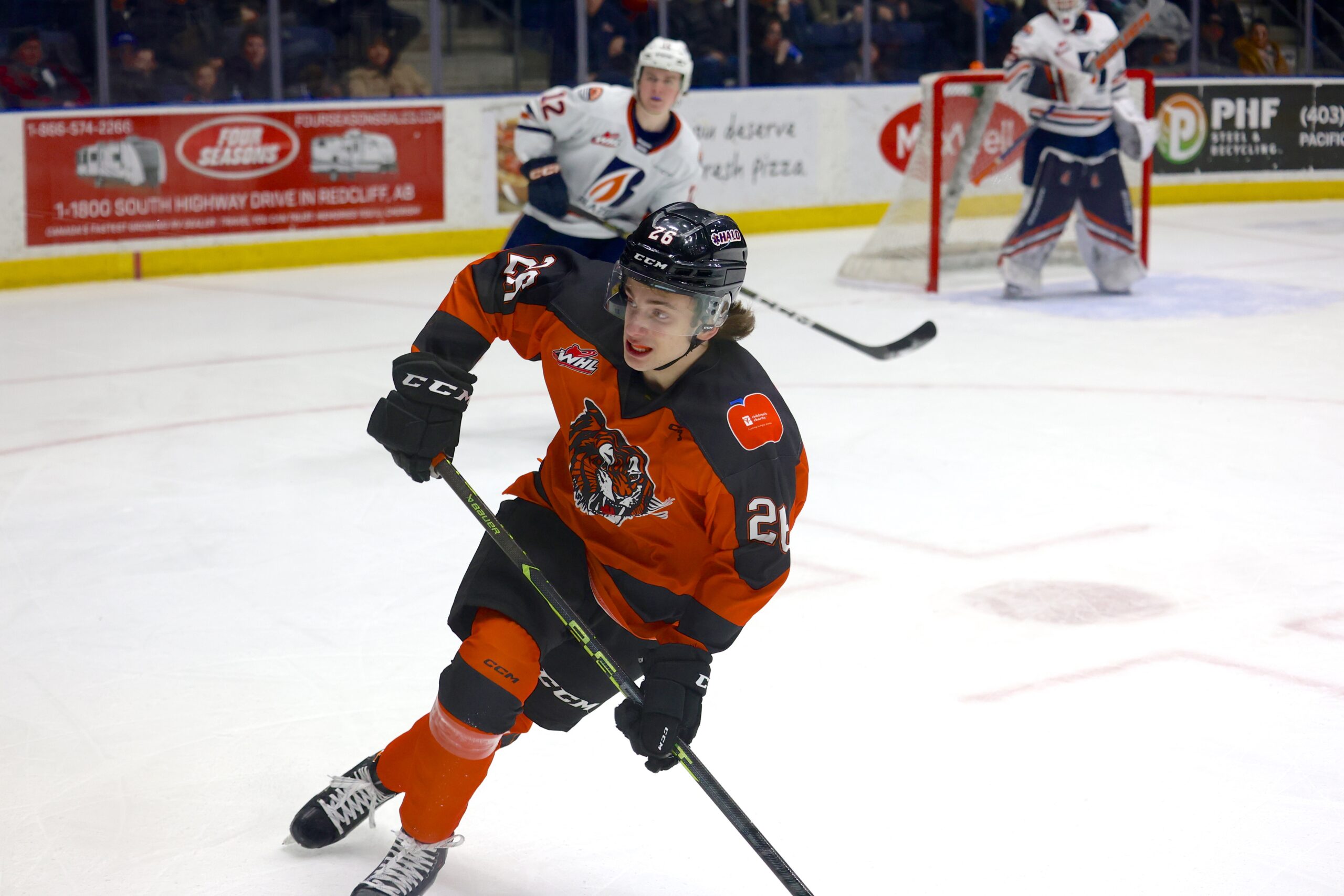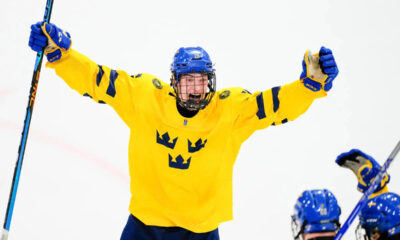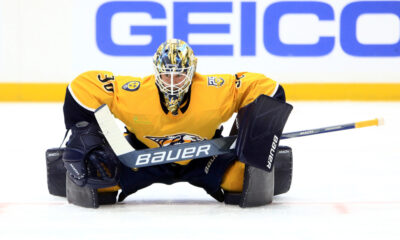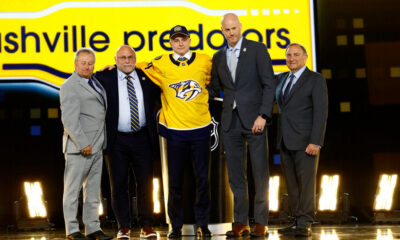On Saturday, the Nashville Predators will draft 99th and 119th overall at the 2024 NHL Draft. While Nashville could use those picks to move up in earlier rounds, there will be plenty of solid prospects available.
This week, I’m picturing what Nashville’s draft board could look like for each of their picks at the 2024 NHL Draft. As always, this will include prospects the Predators should target or may already be connected to.
Heikki Ruohonen | C | Kiekko-Espoo U20 (U20 SM-sarja)
Heikki Ruohonen is as solid of a prospect as they come. The Finnish center stands at 6’1″ and 196 pounds and was a key part of Finland’s international squad this year. Playing for Kiekko-Espoo’s U20 team, Ruohonen scored 20 goals and 47 points in 37 regular-season games. Returning to the U18 World Junior Championship after an injury, the pivot added three goals and five points in five contests.
The foundation of Ruohonen’s game is his skating. It’s not elite by any means but you’d be hard-pressed to find consistent flaws in his mechanics. There’s a bit of a kick to his stride extensions at top speed, but otherwise, Ruohonen uses all his power to move efficiently up and down the ice. On top of that, he can execute solid puck moves at top speed, dropping his shoulder to power around defenders and manipulating his wrists to connect with teammates. If he’s going to succeed in the NHL, it’s probably more as a playmaker than a scorer. But Ruohonen demonstrated plenty of hard work at the junior level when it comes to driving toward scoring positions.
While he won’t dazzle you with elite stick work, I don’t think he gets enough credit for his puckhandling skills; some have labeled Ruohonen as a puck-pusher, but I think that’s unfair.
Defensively, Ruohonen is disciplined, maintaining good positioning for a center. He pressures cycles well, forces turnovers, and can spring breakouts effectively. The knock against him is that he’s a boilerplate, north-south, two-way forward, but I think that underscores how translatable his game is. Ruohonen will come to North America next year before heading to Harvard in 2025.
Topias Hynninen | W | Jukurit (Liiga)
At 5’10” and 170 pounds, Topias Hynninen is a bit on the smaller side. But he’s hard to miss whenever he’s on the ice. The Finnish forward scored nine points in eight games at the U20 level this year, graduating nearly full-time to the Liiga. It’s there he appeared in 43 games for Jukurit, in a bottom-six role, notching a goal and nine points.
Hynninen can be dominant with the puck at the junior level. He hunts the puck with a great motor and keeps his feet moving once he’s gained possession. Playing mostly as a center at the U20 level, Hynninen excelled at breakouts, driving the puck through the neutral zone untouched times. He’s a good puck handler and scans the ice well while moving with pace, setting up teammates with nifty drop passes, creative touches in the cycle, passes to the slot, and more.
Getting more pro experience this year allowed Hynninen to improve his forechecking skills. He can be tenacious against opponents trying to retrieve the puck, using an active stick to disrupt their breakouts. But his size often comes into play and a lack of physicality holds back his impact.
Defensively, Hynninen is frequently well-positioned, providing his defenders with good support and working hard in puck battles along the boards. Like most of his talents, those results dropped off a bit at the pro level. However, he’s got the quickness and intelligence to make an impact if he can add some size and improve his playmaking in high-danger areas.
Luke Osburn | D | Youngstown Phantoms (USHL)
Luke Osburn is a 6’0″ left-shot defender eligible for this draft by just six days. Committed to the University of Wisconsin, he’s not scheduled to attend for another two seasons, but the Michigan native has caught the attention of NHL teams. In 60 games with Youngstown this season, Osburn scored eight times and added another 15 assists, ranking him fourth among team defenders in scoring.
Even at 6’0″, Osburn isn’t the biggest defender. He looks a bit scrawny against bigger opponents and doesn’t have a significant physical edge to his game. But, he is elusive. With or without the puck, Osburn feels constantly ready to explode forward. He turns puck retrievals into quick-developing breakouts with ease and reverses play quickly when he dispossesses an opponent. Whether he’s executing the first pass or not, Osburn usually jumps into the rush, providing close support to his charging teammates.
Defensively, he closes gaps aggressively, using a sweeping stick to thwart opposing puck carriers. His pivots are smooth, but he needs to add consistency to his timing or better ensure he’s not caught up the ice against a fast break. And while his stick has been effective, he’ll need to grow into a frame that can push opponents to the perimeter and control the front of the net too.
Offensively, Osburn is constantly sliding into open ice looking for a passing or shooting opportunity. He distributes the puck from the point fine but prefers to step into the faceoff circles like a fourth forward. His shot isn’t particularly effective right now, but that might be the easiest asset to develop as he looks toward college.
Tomas Mrsic | F | Mediciene Hat Tigers (WHL)
The Medicine Hat Tigers offensive lineup this year was scary to watch. And while he finished fourth on the team in scoring, Tomas Mrsic was a key part of it all. The 6’0″ forward scored 23 goals and 62 points in 63 games for the Tigers.
There are a lot of this Mrsic does fairly well, and there’s one thing he does extremely well: his shot. The British Columbia native is as crafty as they come with the puck on his blade. He’s an efficient puck carrier up and down the ice, getting out of his zone and into the offensive zone with speed. While his first instinct may be to shoot, it’s not a crutch. Mrsic excelled setting up teammates in the slot this year with short-ice, saucer, and no-look passes. But when he does shoot, look out. Mrsic’s release is at the top of this class. His wrist shot is elite, and he can snap a puck off from pretty much any position (mid-stride, from his off side, etc.). He adjusts to the passes he receives so quickly before popping the puck usually in the back of the net.
While he may be a good breakout leader, Mrsic will have to refine his defensive zone game better. He isn’t a liability, but with his pretty good skating mechanics, you’d like to see him be a bit more dynamic in his end. I’m also a tad concerned about his strength and puck-protection skills, but that should come naturally with development. While he’s fast, he won’t be blowing by NHL defenders, so he’ll need to add new wrinkles to his delay game in the offensive zone.
Nate Misskey | D | Victoria Royals (WHL)
Nate Misskey feels destined to become a Nashville Predator—especially after Barry Trotz’s recent comments about adding defenders with size at the draft. The 6’3″ right-shot defender is in his second year of draft eligibility but shouldn’t be skipped over this time. Coming in around 200 pounds, Misskey patrolled the Victoria Royals blueline this year, scoring seven goals and 34 points in 44 games (second on the team’s backend).
Misskey succeeds thanks mostly to his physicality. He closes off opposing puck carriers along the boards, crushes them in the corners, and bothers them relentlessly in front of his net. He’s not the quickest in puck retrievals, but he makes efficient first passes after recovering possession in his end. His gap closures come quickly around the blue line, and his wingspan makes it difficult to deke around him.
The bruising defender is more of a puck manager than a puck handler, but he’s still a crisp passer. In the offensive zone, he drifts down from the blue line to set up teammates with give-and-go opportunities, and he won’t pause before activating when he sees an open slot.
Misskey’s skating isn’t perfect. He’s got powerful stride extensions, but they aren’t always consistent. His acceleration out of his pivots was mostly fine at the junior level but will need to improve in the NHL or else speedier forwards will continue to exploit him. Luckily, Misskey is very good at getting a touch on puck carriers earlier in the rush and driving them wide—a skill that should translate well to an NHL team’s bottom pair.

















